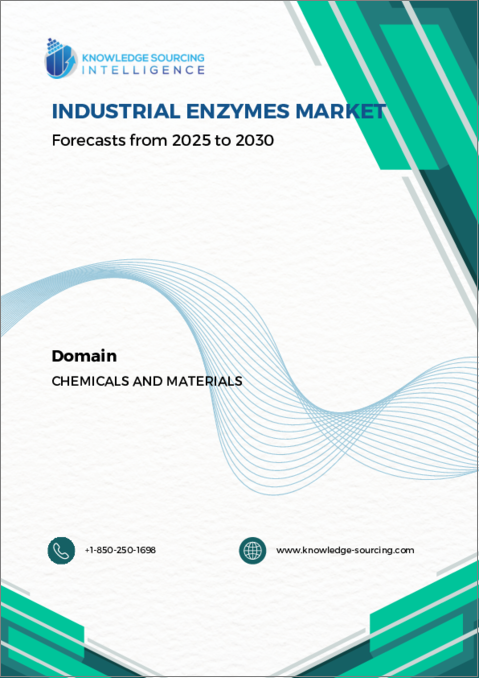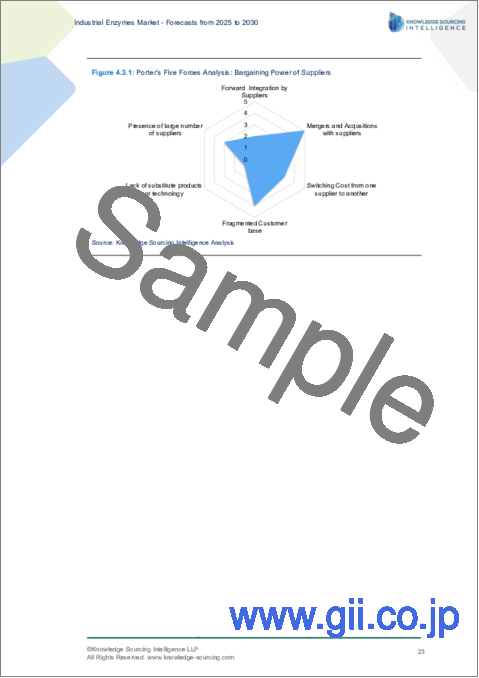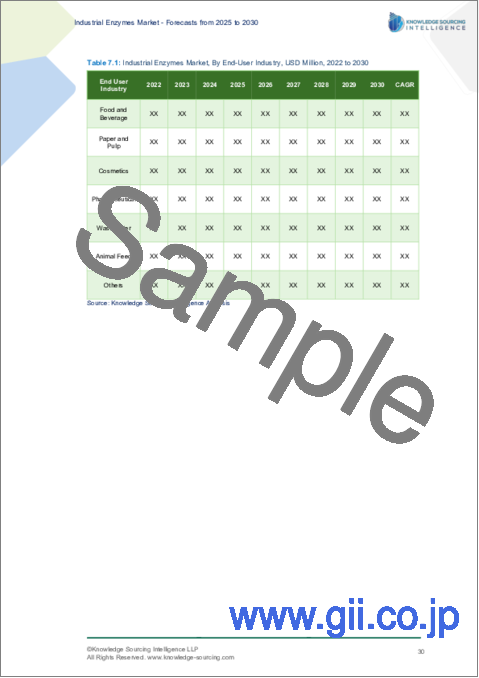|
|
市場調査レポート
商品コード
1627917
工業用酵素市場:予測(2025年~2030年)Industrial Enzymes Market - Forecasts from 2025 to 2030 |
||||||
カスタマイズ可能
|
|||||||
| 工業用酵素市場:予測(2025年~2030年) |
|
出版日: 2024年12月18日
発行: Knowledge Sourcing Intelligence
ページ情報: 英文 141 Pages
納期: 即日から翌営業日
|
- 全表示
- 概要
- 目次
工業用酵素市場はCAGR 7.16%で成長し、2025年の88億4,007万1,000米ドルから2030年には123億7,125万9,000米ドルの市場規模に達すると予測されています。
工業用酵素は商業用酵素の一種で、医薬品、食品・飲料、バイオ燃料、化学生産など複数の産業で使用されています。市場には、アミノペプチダーゼ、リパーゼ、ペクチナーゼ、キシラナーゼなど様々な種類の工業用酵素があります。これらの酵素は、複数の産業において複数の利点を提供します。これらは完全に生分解性であり、プロセスの効率と生産性を高めます。工業用酵素は遺伝子操作も容易で、製品の回収も可能です。また、生産が容易で安価であり、炭素源を削減することができます。
化学分野における世界の需要の高まりは、予測されるタイムラインにおける工業用酵素市場の拡大を促進するでしょう。化学産業では、工業用酵素は主に特定の触媒のプロセスで使用されます。化学薬品に対する世界の需要は、過去数年にわたって一定の成長を遂げています。米国化学工業協会(American Chemistry Council, Inc.)はその報告書の中で、化学製品の生産量は2023年に1.3%の減少を記録したのに対し、2024年には2.2%増加したと述べています。
同様に、化学生産の世界的リーダーであるBASF SEは、その化学産業において、2024年の世界の化学生産は2.7%の成長を遂げると報告しています。同社はさらに、2024年には医薬品部門を除く中国の化学生産が4%の伸びを示し、次いでアジアの他の地域が3%の伸びを示すと述べた。南米と欧州連合地域は、それぞれ1.3%と0.8%の成長でした。
工業用酵素市場の促進要因
- 世界の製薬製品の増加が市場情勢の拡大に貢献
医薬品や医療では、パパイン、アルテプラーゼ、リゾチーム、リパーゼなど様々な種類の酵素が使用されています。これらの酵素は、抗炎症、コレステロール低下など、様々な症例の治療や軽減に役立っています。世界の医薬品・製薬業界の台頭は、市場における工業用酵素の世界の需要を押し上げると予想されます。
さらに、世界の医薬品・製薬業界は、世界のヘルスケアインフラの増加や様々な疾患の症例の増加により、大幅な増加を目の当たりにしています。この医薬品の世界の取引では、ドイツ、スイス、アイルランド、アメリカなどの国々が最大の取引国となっています。
工業用酵素市場の地理的展望
- 北米は予測期間中に飛躍的な成長を遂げます。
米国の工業用酵素市場は、ビジネス促進政策、先進的なバイオテクノロジーインフラ、バイオ燃料、食品・飲料、医薬品などの産業における持続可能なソリューションに対する需要の増加など、酵素メーカーやユーザーを支援する良好なビジネス環境により、今後数年間で成長する見込みです。
さらに、米国の食品・飲料セクターにおける工業用酵素の需要は、より自然で、クリーンラベルで、持続可能な食品加工ソリューションが増加するにつれて伸びると思われます。最も一般的な用途としては、製パン、乳製品、醸造、ジュース製造などの用途における生産効率の向上、食感、風味、保存性の改善、処理時間の短縮などが挙げられます。さらに、より健康的で最小限の加工しか施されていない食品に対する消費者の嗜好は、メーカーが酵素ベースのソリューションを採用するきっかけとなり、市場の成長を後押しします。
本レポートを購入する理由
- 洞察に満ちた分析:顧客セグメント、政府政策と社会経済要因、消費者嗜好、産業別、その他のサブセグメントに焦点を当て、主要地域および新興地域を網羅する詳細な市場考察を得ることができます。
- 競合情勢:世界の主要企業が採用する戦略的作戦を理解し、適切な戦略による市場浸透の可能性を理解することができます。
- 市場動向と促進要因:ダイナミックな要因と極めて重要な市場動向、そしてそれらが今後の市場展開をどのように形成していくかを探ります。
- 実行可能な提言:ダイナミックな環境の中で新たなビジネスストリームと収益を発掘するための戦略的決断を下すために、洞察を活用します。
- 幅広い利用者に対応:新興企業、研究機関、コンサルタント、中小企業、大企業にとって有益で費用対効果が高いです。
どのような用途で利用されていますか?
業界および市場考察、事業機会評価、製品需要予測、市場参入戦略、地理的拡大、設備投資の決定、規制の枠組みと影響、新製品開拓、競合の影響
調査範囲
- 2022年から2030年までの過去データおよび予測
- 成長機会、課題、サプライチェーンの展望、規制枠組み、顧客行動、およびトレンド分析
- 競合のポジショニング、戦略、および市場シェア分析
- セグメントおよび各国を含む地域の収益成長および予測分析
- 企業プロファイリング(特に主要な開発)
目次
第1章 イントロダクション
- 市場概要
- 市場の定義
- 調査範囲
- 市場セグメンテーション
- 通貨
- 前提条件
- 基準年と予測年のタイムライン
- ステークホルダーにとっての主なメリット
第2章 調査手法
- 調査デザイン
- 調査プロセス
第3章 エグゼクティブサマリー
- 主な調査結果
- CXOの視点
第4章 市場力学
- 市場促進要因
- 市場抑制要因
- ポーターのファイブフォース分析
- 業界バリューチェーン分析
- アナリストビュー
第5章 工業用酵素市場:製品別
- イントロダクション
- リパーゼ
- ヌクレアーゼ
- 炭水化物分解酵素
- ポリメラーゼ
- その他
第6章 工業用酵素市場:由来別
- イントロダクション
- 動物
- 植物
- 微生物
- 藻類
第7章 工業用酵素市場:用途別
- イントロダクション
- 水処理
- 空気清浄
第8章 工業用酵素市場:最終用途産業別
- イントロダクション
- 食品・飲料
- 紙・パルプ
- 化粧品
- 製薬
- 医薬品有効成分(API)
- 体外診断
- その他
- 廃水
- 動物飼料
- その他
- ヘルスケア
- 半導体
第9章 工業用酵素市場:地域別
- イントロダクション
- 北米
- 製品別
- 由来別
- 最終用途産業別
- 国別
- 南米
- 製品別
- 由来別
- 最終用途産業別
- 国別
- 欧州
- 製品別
- 由来別
- 最終用途産業別
- 国別
- 中東・アフリカ
- 製品別
- 由来別
- 最終用途産業別
- 国別
- アジア太平洋
- 製品別
- 由来別
- 最終用途産業別
- 国別
第10章 競合環境と分析
- 主要企業と戦略分析
- 市場シェア分析
- 合併、買収、合意およびコラボレーション
- 競合ダッシュボード
第11章 企業プロファイル
- ADM
- DuPont t de Nemours Inc.
- NOVOZYMES A/S
- BASF SE
- DSM-Firmenich
- ABF Ingredients
- Amano Enzyme Inc.
- Lonza Group AG
- Ginkgo Bioworks Holdings Inc.
- Shin-Nihon Chemical Co., Ltd.
- Thermo Fisher Scientific Inc.
- LIVZYM
- Kerry Group
- AB Enzymes
- Lumis Biotech Pvt. Ltd.
The industrial enzymes market is expected to grow at a CAGR of 7.16%, reaching a market size of US$12,371.259 million in 2030 from US$8,840.071 million in 2025.
Industrial enzymes are a form of commercial enzymes, which is used across multiple industries, like pharmaceuticals, food & beverages, biofuels, and chemical productions. Various types of industrial enzymes are available across the market, including aminopeptidase, lipases, pectinases, and xylanases, among many others. These enzymes offer multiple benefits in multiple industries. They are fully biodegradable and enhance the efficiency and productivity of processes. Industrial enzymes are also easy to manipulate genetically and offer product recovery. It is also easy and cheaper to produce and reduces the carbon sources.
The growing global demand for the chemical sector will propel the industrial enzymes market expansion during the forecasted timeline. In the chemical industry, industrial enzymes are mainly used in the process of specific catalysts. The global demand for chemicals has witnessed constant growth over the past few years. The American Chemistry Council, Inc., in its report, stated that the volume of chemical output grew by 2.2% in 2024, compared to 2023, which recorded a decline of 1.3% in volume output.
Similarly, BASF SE, a global leader in chemical production, reported in its chemical industry that global chemical production will witness a growth of 2.7% in 2024. The company further stated that in 2024, chemical production, excluding the pharmaceutical sector, in China witnessed a growth of 4%, followed by 3% in other parts of Asia. The South American and European Union regions witnessed a growth of 1.3% and 0.8%, respectively.
Industrial enzymes market drivers
- The increase in the global pharma product landscape is contributing to the industrial enzymes market expansion
In drugs and medicine, various types of enzymes like papain, alteplase, lysozyme, and lipase. These enzymes help in the cure and reduction of various cases like anti-inflammatory, lower cholesterol, and others. The rise in the global drug and pharma industry is expected to boost the global demand for industrial enzymes in the market.
Moreover, the global pharma and drug industry has witnessed a significant increase that can be credited to the increase in the global healthcare infrastructure and the rise in the cases of various diseases. In this global trade of pharmaceutical products, countries like Germany, Switzerland, Ireland, and the USA are among the biggest traders of the products.
Industrial Enzymes Market Geographical Outlook
- North America is witnessing exponential growth during the forecast period.
The United States industrial enzyme market is growing in the coming years due to a favourable business environment where it supports the enzyme manufacturers and users through pro-business policies, advanced biotechnology infrastructure, and increasing demand for sustainable solutions across industries like biofuels, food & beverages, and pharmaceuticals.
Furthermore, the demand for industrial enzymes in the U.S. food and beverage sector will grow as there is an increase in more natural, clean-label, and sustainable food processing solutions. Some of the most common uses include increased production efficiency, improved texture, flavour, and shelf life, and reduced processing times in applications such as baking, dairy, brewing, and juice production. Additionally, consumer preferences for healthier and minimally processed foods will increasingly lead manufacturers to adopt enzyme-based solutions, thus boosting market growth.
Reasons for buying this report:-
- Insightful Analysis: Gain detailed market insights covering major as well as emerging geographical regions, focusing on customer segments, government policies and socio-economic factors, consumer preferences, industry verticals, other sub- segments.
- Competitive Landscape: Understand the strategic maneuvers employed by key players globally to understand possible market penetration with the correct strategy.
- Market Drivers & Future Trends: Explore the dynamic factors and pivotal market trends and how they will shape up future market developments.
- Actionable Recommendations: Utilize the insights to exercise strategic decision to uncover new business streams and revenues in a dynamic environment.
- Caters to a Wide Audience: Beneficial and cost-effective for startups, research institutions, consultants, SMEs, and large enterprises.
What do businesses use our reports for?
Industry and Market Insights, Opportunity Assessment, Product Demand Forecasting, Market Entry Strategy, Geographical Expansion, Capital Investment Decisions, Regulatory Framework & Implications, New Product Development, Competitive Intelligence
Report Coverage:
- Historical data & forecasts from 2022 to 2030
- Growth Opportunities, Challenges, Supply Chain Outlook, Regulatory Framework, Customer Behaviour, and Trend Analysis
- Competitive Positioning, Strategies, and Market Share Analysis
- Revenue Growth and Forecast Assessment of segments and regions including countries
- Company Profiling (Strategies, Products, Financial Information, and Key Developments among others)
The industrial enzymes market is segmented and analyzed as follows:
By Product
- Lipase
- Nuclease
- Carbohydrase
- Polymerase
- Others
By Source
- Animal
- Plant
- Microorganism
- Algae
By End-User Industry
- Food and Beverage
- Paper and Pulp
- Cosmetics
- Pharmaceutical
- Active Pharmaceutical Ingredients (API)
- In-Vitro Diagnostics
- Others
- Wastewater
- Animal Feed
- Others
- Healthcare
- Functional Foods
- Supplements
- Others
- Semiconductor
- Enzymes for Product Manufacturing
- Others
By Geography
- North America
- USA
- Canada
- Mexico
- South America
- Brazil
- Argentina
- Others
- Europe
- United Kingdom
- Germany
- France
- Italy
- Others
- Middle East and Africa
- UAE
- Saudi Arabia
- Israel
- Others
- Asia Pacific
- Japan
- China
- India
- South Korea
- Taiwan
- Thailand
- Indonesia
- Others
TABLE OF CONTENTS
1. INTRODUCTION
- 1.1. Market Overview
- 1.2. Market Definition
- 1.3. Scope of the Study
- 1.4. Market Segmentation
- 1.5. Currency
- 1.6. Assumptions
- 1.7. Base and Forecast Years Timeline
- 1.8. Key Benefits to the Stakeholder
2. RESEARCH METHODOLOGY
- 2.1. Research Design
- 2.2. Research Processes
3. EXECUTIVE SUMMARY
- 3.1. Key Findings
- 3.2. CXO Perspective
4. MARKET DYNAMICS
- 4.1. Market Drivers
- 4.2. Market Restraints
- 4.3. Porter's Five Forces Analysis
- 4.3.1. Bargaining Power of Suppliers
- 4.3.2. Bargaining Power of Buyers
- 4.3.3. Threat of New Entrants
- 4.3.4. Threat of Substitutes
- 4.3.5. Competitive Rivalry in the Industry
- 4.4. Industry Value Chain Analysis
- 4.5. Analyst View
5. INDUSTRIAL ENZYMES MARKET BY PRODUCT
- 5.1. Introduction
- 5.2. Lipase
- 5.3. Nuclease
- 5.4. Carbohydrase
- 5.5. Polymerase
- 5.6. Others
6. INDUSTRIAL ENZYMES MARKET BY SOURCE
- 6.1. Introduction
- 6.2. Animal
- 6.3. Plant
- 6.4. Microorganism
- 6.5. Algae
7. INDUSTRIAL ENZYMES MARKET BY APPLICATION
- 7.1. Introduction
- 7.2. Water Treatment
- 7.3. Air Purification
8. INDUSTRIAL ENZYMES MARKET BY END-USER INDUSTRY
- 8.1. Introduction
- 8.2. Food and Beverage
- 8.3. Paper and Pulp
- 8.4. Cosmetics
- 8.5. Pharmaceutical
- 8.5.1. Active Pharmaceutical Ingredients (API)
- 8.5.2. In-Vitro Diagnostics
- 8.5.3. Others
- 8.6. Wastewater
- 8.7. Animal Feed
- 8.8. Others
- 8.8.1. Healthcare
- 8.8.1.1. Functional Foods
- 8.8.1.2. Supplements
- 8.8.1.3. Others
- 8.8.2. Semiconductor
- 8.8.2.1. Enzymes for Product Manufacturing
- 8.8.2.2. Others
- 8.8.1. Healthcare
9. INDUSTRIAL ENZYMES MARKET BY GEOGRAPHY
- 9.1. Introduction
- 9.2. North America
- 9.2.1. By Product
- 9.2.2. By Source
- 9.2.3. By End-User Industry
- 9.2.4. By Country
- 9.2.4.1. USA
- 9.2.4.2. Canada
- 9.2.4.3. Mexico
- 9.3. South America
- 9.3.1. By Product
- 9.3.2. By Source
- 9.3.3. By End-User Industry
- 9.3.4. By Country
- 9.3.4.1. Brazil
- 9.3.4.2. Argentina
- 9.3.4.3. Others
- 9.4. Europe
- 9.4.1. By Product
- 9.4.2. By Source
- 9.4.3. By End-User Industry
- 9.4.4. By Country
- 9.4.4.1. United Kingdom
- 9.4.4.2. Germany
- 9.4.4.3. France
- 9.4.4.4. Italy
- 9.4.4.5. Others
- 9.5. Middle East and Africa
- 9.5.1. By Product
- 9.5.2. By Source
- 9.5.3. By End-User Industry
- 9.5.4. By Country
- 9.5.4.1. UAE
- 9.5.4.2. Saudi Arabia
- 9.5.4.3. Israel
- 9.5.4.4. Others
- 9.6. Asia Pacific
- 9.6.1. By Product
- 9.6.2. By Source
- 9.6.3. By End-User Industry
- 9.6.4. By Country
- 9.6.4.1. Japan
- 9.6.4.2. China
- 9.6.4.3. India
- 9.6.4.4. South Korea
- 9.6.4.5. Taiwan
- 9.6.4.6. Thailand
- 9.6.4.7. Indonesia
- 9.6.4.8. Others
10. COMPETITIVE ENVIRONMENT AND ANALYSIS
- 10.1. Major Players and Strategy Analysis
- 10.2. Market Share Analysis
- 10.3. Mergers, Acquisitions, Agreements, and Collaborations
- 10.4. Competitive Dashboard
11. COMPANY PROFILES
- 11.1. ADM
- 11.2. DuPont t de Nemours Inc.
- 11.3. NOVOZYMES A/S
- 11.4. BASF SE
- 11.5. DSM-Firmenich
- 11.6. ABF Ingredients
- 11.7. Amano Enzyme Inc.
- 11.8. Lonza Group AG
- 11.9. Ginkgo Bioworks Holdings Inc.
- 11.10. Shin-Nihon Chemical Co., Ltd.
- 11.11. Thermo Fisher Scientific Inc.
- 11.12. LIVZYM
- 11.13. Kerry Group
- 11.14. AB Enzymes
- 11.15. Lumis Biotech Pvt. Ltd.





